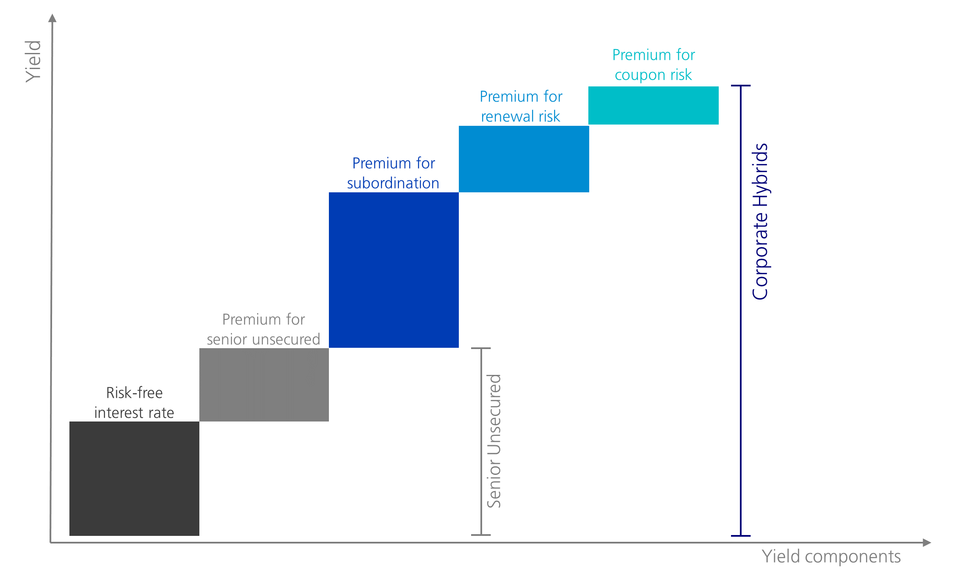Corporate hybrid bonds: rapid growth
Corporate hybrids are subordinated bonds issued by first-class non-financial companies. As these bonds can partially be classed as share capital by rating agencies, issuers can boost their creditworthiness with the hybrid capital. In the capital structure of the issuers, corporate hybrids are subordinated to other debts except for share capital. The attractive risk and return profile provides the asset class with rapid growth.
Text: Hagen Fuchs , Daniele Paglia

In the event of bankruptcy, the bond investors would therefore only be compensated after the other creditors. In contrast to senior debt securities, hybrids receive a rating that is approximately two levels lower due to their subordination. Conversely, yields on hybrids are higher than those of senior debt securities.
Typical structure of a corporate hybrid bond
Corporate hybrids have a very long or infinite remaining term (perpetual), but usually have an initial call date after 5 to 10 years. The coupon is fixed until the first call date, after which the basic interest rate and credit risk premium may be redefined.
According to market convention, corporate hybrids are priced at the earliest possible call date. This is because the issuers have a very great incentive to repay the bonds on the first call date: If an issuer does not repay the hybrid on the first call date, the bond loses its eligibility to be considered as share capital with the rating agency S&P, for example. From the issuer's point of view, the hybrid then becomes a very expensive senior bond.
Corporate hybrids are not bail-in instruments like CoCo bonds and are therefore not subject to any conversion, whether automatic or effected by the regulator.
Strong growth and stability even during crisis
The corporate hybrids market has grown strongly in recent years and has evolved into a mature investment segment where diversified investing is possible. Over the last ten years, the market for corporate hybrids has grown sixfold. The current size corresponds to approximately USD 188 billion in outstanding bonds, which is two thirds of the size of the CoCo market. Investors can currently select from 180 bonds from 81 well-known issuers.
Issuers in the market for corporate hybrids

During the disruptions caused by the coronavirus pandemic in the first quarter of 2020, the market was subjected to an initial, extreme stress test, which it passed with distinction. Despite high market volatility, corporate hybrids were always liquid and rationally priced. This put them in a much better shape than high-yield and emerging market bonds.
Green bonds, ESG criteria and CO2 reduction
From a sustainability perspective, the corporate hybrids universe can also offer some advantages. More than 10 percent of the issue volume of corporate hybrids already consists of green bonds, i.e. bonds that are used to raise capital for activities that favour the environment and climate protection. This trend is increasing. For comparison: in the global corporate bond market, the share of green bonds is currently less than 2 percent.
Moreover, corporate hybrid issuers have significantly better ESG ratings in addition to a lower CO2e-intensity compared to the global average.
Asset class with an attractive risk and return profile
Investors are compensated with a yield premium in exchange for the risks specific to hybrids, as shown in Figure 1. Figure 2 shows that their historical performance is therefore similar to senior bonds from high-yield issuers, even though they are issued by issuers with an investment-grade rating.
Remember: the default risk of a senior bond and a hybrid bond of the same issuer is identical. In the event of a default, the expected loss with hybrids compared to seniors is, however, higher (due to subordination).
Figure 1: Higher credit risk premium with the same issuer rating

Successful investment only with the right investment process
Successful investments in corporate hybrids require a disciplined and clear investment process that combines classic fundamental research and systematic quant models. Ideally, both a data-driven, top-down selection of the most attractive segments of the hybrid universe at the time and a thorough bottom-up credit analysis of each debtor selected in the shortlist should play a role. Furthermore, the specific structural characteristics of each bond must be analysed before taking the investment decision.
Figure 2: Yield components of corporate hybrid bonds



